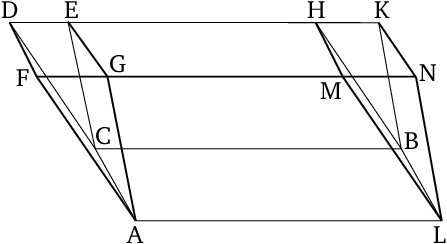Proof: By Euclid
(related to Proposition: Prop. 11.29: Parallelepipeds on Same Base and Same Height whose Extremities are on Same Lines are Equal in Volume)
- For let the parallelepiped solids $CM$ and $CN$ be on the same base $AB$, and (have) the same height, and let the (ends of the straight lines) standing up in them, $AG$, $AF$, $LM$, $LN$, $CD$, $CE$, $BH$, and $BK$, be on the same straight lines, $FN$ and $DK$.
- I say that solid $CM$ is equal to solid $CN$.

- For since $CH$ and $CK$ are each parallelograms, $CB$ is equal to each of $DH$ and $EK$ [Prop. 1.34].
- Hence, $DH$ is also equal to $EK$.
- Let $EH$ have been subtracted from both.
- Thus, the remainder $DE$ is equal to the remainder $HK$.
- Hence, triangle $DCE$ is also equal to triangle $HBK$ [Prop. 1.4], [Prop. 1.8], and parallelogram $DG$ to parallelogram $HN$ [Prop. 1.36].
- So, for the same (reasons), traingle $AFG$ is also equal to triangle $MLN$.
- And parallelogram $CF$ is also equal to parallelogram $BM$, and $CG$ to $BN$ [Prop. 11.24].
- For they are opposite.
- Thus, the prism contained by the two triangles $AFG$ and $DCE$, and the three parallelograms $AD$, $DG$, and $CG$, is equal to the prism contained by the two triangles $MLN$ and $HBK$, and the three parallelograms $BM$, $HN$, and $BN$.
- Let the solid whose base (is) parallelogram $AB$, and (whose) opposite (face is) $GEHM$, have been added to both (prisms).
- Thus, the whole parallelepipedal solid $CM$ is equal to the whole parallelepipedal solid $CN$.
- Thus, parallelepiped solids which are on the same base, and (have) the same height, and in which the (ends of the straight lines) standing up (are) on the same straight lines, are equal to one another.
- (Which is) the very thing it was required to show.
∎
Thank you to the contributors under CC BY-SA 4.0! 

- Github:
-

- non-Github:
- @Fitzpatrick
References
Adapted from (subject to copyright, with kind permission)
- Fitzpatrick, Richard: Euclid's "Elements of Geometry"
